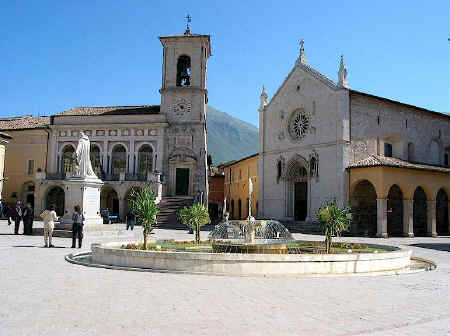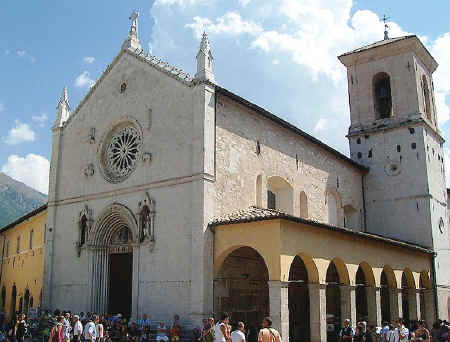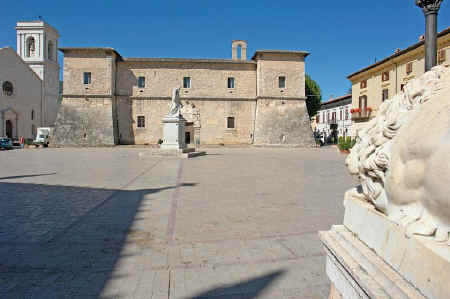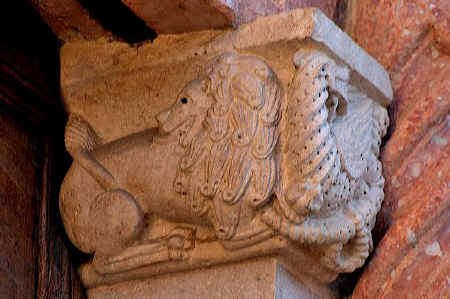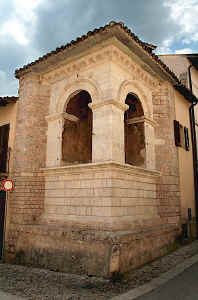A good starting point for a walking tour of Norcia can be made by entering the town through the Roman Gate and walking along the 19 C Corso Sertorio to the main piazza, dedicated to San Benedetto (Saint Benedict). Here Norcia's most important buildings overlook the statue of San Benedetto (Giuseppe Prinzi, 1880). The Palazzo Comunale (Town hall), constructed in the 13 C, was restored in various different periods because of the frequent earthquakes. Of the 13 C construction there remains the portico, with its short, stout columns, while the upper part took on its current aspect after the earthquake of 1859.
Basilica of San Benedetto of NorciaOn the right side of the Palazzo Comunale stands the Basilica of San Benedetto, which has a 14 C gabled fašade in Gothic style. With its lovely portal bordered by clusters of small columns, the basilica rises above the ruins of a 1 C -2 C Roman edifice, identified by tradition as the home where St. Benedict was born. Basilica of San Benedetto
Tragically, the Basilica was
severely damaged during the earthquake The interior, with its Latin-cross plan, has undergone various alterations over the centuries, and does not adhere to a specific style: Romanesque, Gothic and Baroque elements are mixed together. Half-way along the nave, via two lateral stairways, the visitor can enter the crypt, which contains the remains of the Roman edifice dating to the 1 C - 2 C AD. The Portico of Measurements was set against the right-hand side of the church around 1570 in order to create a sort of open market for grain.
The Castellina of NorciaThe fortress occupying the entire western side of the square, called the Castellina, was a fortified residence for the papal governors. Prefects appointed by Rome established themselves here in 1569, with jurisdiction over a vast territory known as the Mountain Prefecture. Begun in 1554, the edifice was designed by Vignola. The portal, courtyard and stairway to the upper floor are all magnificent. Today the Castellina is the seat of the Civic and Diocesan museum. Castellina di Norcia Co-cathedral of Santa Maria ArgenteaThe Co-cathedral of Santa Maria Argentea is of very ancient origin. At the time of the Roman empire, on the site where the Castellina currently stands, there was a temple dedicated to the goddess Fortuna Argentea but converted into a Christian edifice in the 3 C. The remains of the ancient parish church can still be seen in the dungeons of the Castellina. The present-day church was constructed between 1556 and 1570 in Renaissance style, with large stone arcs and aristocratic chapels. It presents a simple gabled fašade in white stone and an elegant portal with wooden doors dating to 1576. The side portal is Gothic in style (late 14 C) and was made with materials from the demolished parish church. After damage by an earthquake, it was restored in neoclassical style in the 18 C. The interior preserves numerous works of art including the 1494 wooden crucifix by Giovanni Tedesco, a painting by Giuseppe Paladini (1756) and, in the Misericordia chapel, Francesco Duquesnoy's magnificent altar (1640) and an exquisite 16 C fresco with the image of the Madonna and Child and Saints Benedict and Scholastica. Church of San Francesco, NorciaIn Piazza Garibaldi, the former church of San Francesco, is one of the most important examples of Gothic art in the area, with remarkable interior frescoes dating from the 15 C and 16 C. The church is the result of the reconstruction carried out by the Franciscans around 1385, the year in which the rose-window on the fašade was being executed. It was heavily damaged by the earthquake of 1859. The complex of San Francesco now houses an auditorium, library and the municipal historical archive. Early capital in the Church of San Francesco in Norcia Going back towards the higher part of the village, along via Anicia, you will find the Church of Sant'Agostino. Its interior houses wooden baroque altars, a 17 C walnut choir and interesting votive frescoes on the counter-fašade (14C -16 C) and in the lateral walls (16 C -17 C). TempiettoIn via Umberto, a short distance from via Anicia, there is an interesting votive shrine: the Tempietto (Little Temple). It is a small Romanesque-Gothic monument dating to 1354. The work of a local artist, Vanni della Tuccia, it is the best preserved and most original historical edifice in Norcia. Tempietto
In the Capolaterra quarter, whose cottages with their white fašades have almost all been restored, the
Oratory of Sant'Agostinuccio in Piazza Palatina is worth a visit, with its magnificent golden and painted wooden ceiling and
17 C walnut seats.
|
||||||||||||||||||||||||||||||
